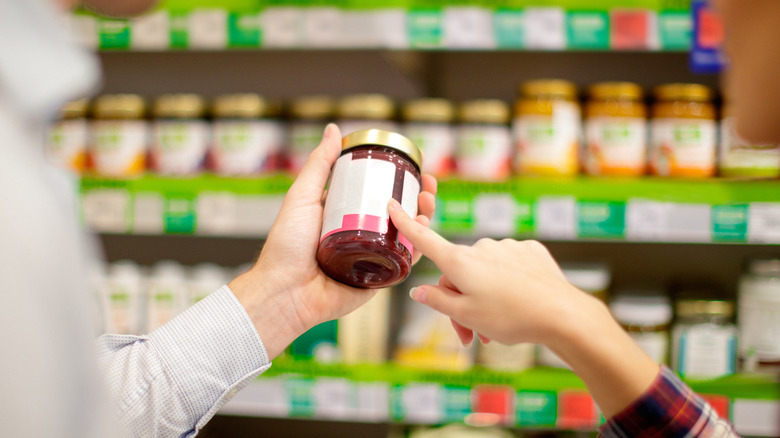Why You Should Avoid The First Product On The Grocery Store Shelf
Grocery stores stock products in all sorts of clever ways, like pushing certain brands by placing them at eye-level, or stocking impulse-buy candy at kiddo eye-level. It might seem sneaky, but according to the Food Marketing Institute, the average supermarket carries an estimated 31,530 items as of 2022. That's a lot of products to keep track of — which is why many stores stock by expiration date.
Chances are, the item in the very front of a grocery display has the soonest expiration date. In the industry, stocking this way is called the "FIFO" Method (as in, first-in, first-out). By checking the back of the shelf, you might find a product with an expiration date several days (or even longer) later than the most easily accessible item out front. Admittedly, this might seem like an extra chore if you're running errands in a hurry and don't really have time to thoroughly inspect every item. But, taking those few extra seconds to reach for a father-back item could be well worth it to make your groceries stretch.
It's worth mentioning that not every grocery store absolutely follows this rule, but in general, the FIFO Method is common industry practice. In many grocery stores, expired or otherwise unfit-for-sale items are culled out by the night staff. Sometimes, they find new life in food banks and pantries before they spoil. Some deli items are rescued by in-store deli counters before the ingredients go bad.
It's all about the expiration date
Still, take those expiration dates with a grain of salt when checking store shelves. According to the USDA, misunderstandings about what food label dates mean account for around a third of the food waste observed among consumers and retailers, who toss food that's safe to eat. Indeed, "Best by" versus "sell by" and "best if used by" can quickly become perplexing.
In the U.S., no grocery items except for baby formula are subjected to regulated expiration codes. So people shopping for infants and young children may especially want to keep FIFO labels on dates in mind. But generally, what constitutes "going bad" differs from state to state, and sometimes differs on smaller local levels. Even the USDA's Food Safety and Inspection Service (FSIS) differentiates between the expiration date and how safe food is to consume: "If the date passes during home storage, a product should still be safe and wholesome if handled properly until the time spoilage is evident. Spoiled foods will develop an off odor, flavor or texture." According to chef-slash-journalist Tamar Adler, "It's really hard to imagine you're supposed to trust your own nose and mouth," via Vox. Meanwhile, assumptions about the importance of info on labels discourage people from fully utilizing their food.
At the end of the day, expiration dates may still help consumers know when a certain product will taste its best. Taking the extra moment to check the back of the shelf can help ensure your groceries are at their peak quality.

